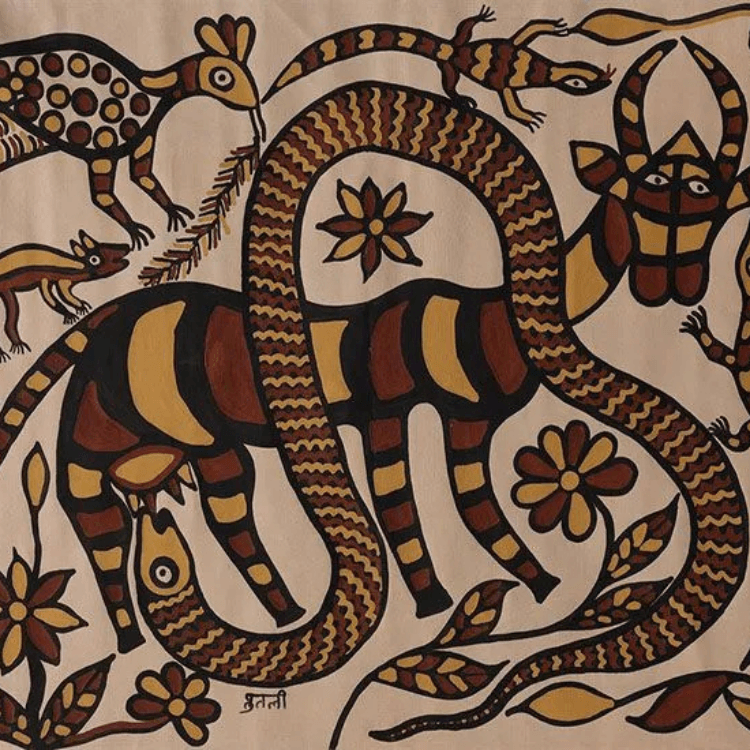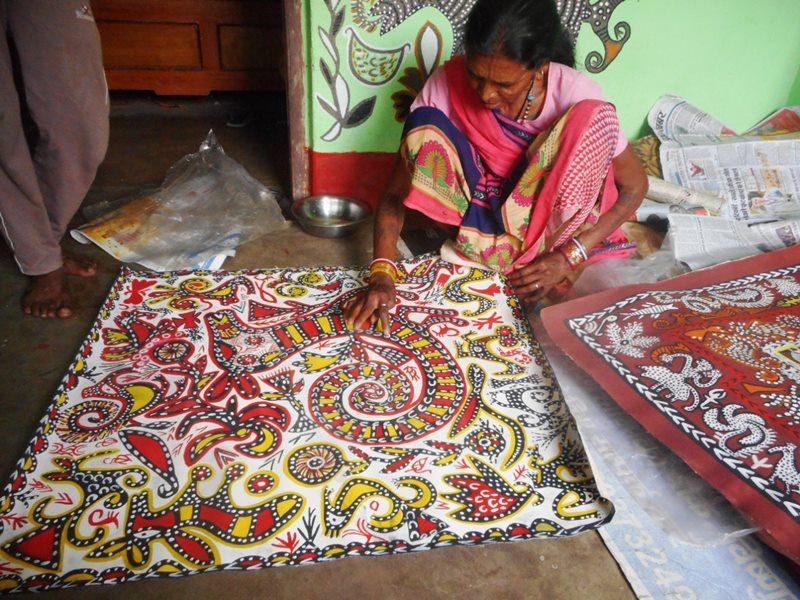
Your Cart
The Stories on Walls - Art of Sohrai

The art of storytelling has been an integral part of human culture since the beginning of time. From cave paintings to modern-day cinema, we have always found ways to express our experiences and emotions through visual narratives. In India, one such form of storytelling is the tribal art of Sohrai, where vibrant murals are painted on the walls of houses to depict rural life and customs. With the GI tag up its sleeve, the art of Sohrai is not just a means of creative expression. It is also a reflection of the unique identity and rich cultural heritage of the region.
The History of Sohrai Art -------------------------
Sohrai art form has been practised for centuries by the tribes of Hazaribagh, Jharkhand, and its surrounding states. 'Sohrai' is derived from the Mundari term 'Soroi,' which means 'to whip with a stick.' Whipping with the stick is related to livestock.
These tribals heavily depend on domestic animals for agriculture, food, and living. Every year they celebrate the Sohrai festival with great fervour. And on this occasion, they celebrate the harvest by expressing gratitude towards the deities and the livestock.
Sohrai art is an integral part of the festival, and it is during this time the adivasi women create paintings on the walls of their maati ghar, celebrating nature's abundance and the fruitful harvest.
The Technique of Sohrai Art ---------------------------
Sohrai paintings use natural pigments derived from clay, charcoal, cow dung, and leaves. The artists use their fingers, twigs, and brushes made from animal hair to create intricate designs and patterns on the walls.
The paintings are usually done on a white base, mixing cow dung with water and clay. The artists then draw the outlines of the design using charcoal and fill them in with bright colours.

The Significance of Sohrai Art ------------------------------
The art form is passed down from one generation to the next, and it plays a crucial role in maintaining the tribe's identity and traditions. The paintings are also believed to bring good luck and prosperity to the household.
The themes of Sohrai paintings are usually centred around rural life and customs. The paintings depict scenes of daily life, such as women grinding wheat, farmers ploughing the fields, and children playing in the village.
The paintings also depict mythological stories and traditional beliefs of the tribe. The art of Sohrai is not just a form of creative expression but also a means of preserving the cultural heritage of the region.
Design Tools, Color Palettes, and the Process ---------------------------------------------
The process of making Sohrai art is a labour-intensive and time-consuming process. The artisans who create this art form use various tools, including brushes made from animal hair and bamboo sticks.
The colour palette used for the art is derived from natural sources, such as indigo, turmeric, and charcoal. Creating the art involves applying a mixture of cow dung and mud to the walls, allowing it to dry, and then painting the images using natural colours.
The end result is a beautiful and intricate work of art that reflects the rich cultural heritage of Jharkhand.
Current Scenario of Sohrai Art and Artisans -------------------------------------------
Despite its rich cultural heritage, the art of Sohrai is facing numerous challenges. Modernization has led to the construction of concrete houses that do not provide suitable surfaces for Sohrai paintings.
Also, the popularity of modern and contemporary art forms has led to a decline in demand for traditional art forms such as Sohrai. This has resulted in a decrease in the number of artisans practising the art form.
Many of the younger generations are not interested in learning the art form and are instead opting for more modern and lucrative professions. This has resulted in a shortage of skilled artisans who can create this beautiful art form.

However, efforts are being made to preserve this unique art form. Various NGOs and government initiatives are working towards creating awareness and promoting Sohrai art. The art form has also gained popularity among art enthusiasts, and many artists are now creating contemporary versions of Sohrai paintings.
They have set up several training centres where young artisans can learn the art form and improve their skills. They have also provided financial assistance to the artisans to help them market their products and reach a wider audience.
Conclusion ----------
India has a rich and diverse cultural heritage, and its traditional art forms are an integral part of this identity. Sohrai art is just one example of the many unique art forms nationwide.
Despite facing challenges, efforts are being made to preserve this beautiful art form. By supporting and promoting Sohrai art, we can help preserve this ancient tradition for future generations to enjoy and appreciate. It is a reminder of the importance of preserving cultural heritage and the role that art plays in keeping traditions alive.
Did you find this blog interesting? To know more about Indian art, stay tuned with Rooftop. Join us on Instagram @rooftop_app for all the latest updates, and download the Rooftop app available for both iOS and Android devices.